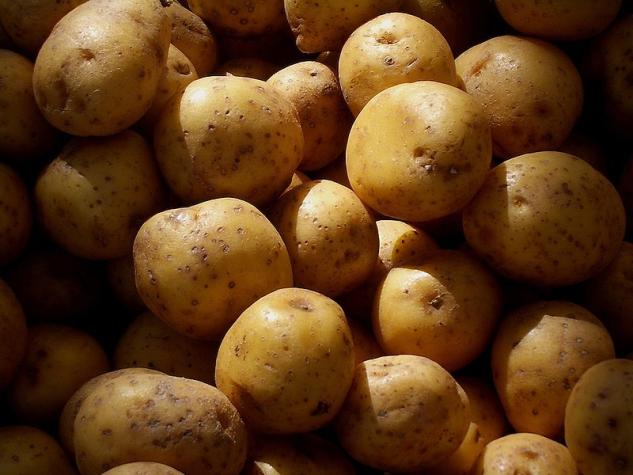COLUMBIA, Mo. – The idea that potatoes should be planted on St. Patrick’s Day is probably good advice for some parts of our country, but not for Missouri, said University of Missouri Extension state horticulturist David Trinklein.
“Although the arrival of warm weather varies each spring, March 17 normally is a bit too early,” Trinklein said. “Gardeners are advised to plant according to local conditions and not by calendar date. Wait to plant potatoes until soil temperatures warm to above 45 degrees.”
The association of potato planting with St. Patrick’s Day pays homage to the important role this vegetable played in 19th-century Ireland. According to some estimates, the average Irish laborer of the era ate an astounding 12-14 pounds of potatoes daily.
This dependence on a single food source was a primary reason for the devastating consequences of the Irish potato famine of the 1840s. Late blight disease (Phytophthora infestans) destroyed most of Ireland’s potato crop for several years in a row. Ireland lost 1.5 million people to starvation and related illnesses during the famine.
Potato (Solanum tuberosum) is a member of the Solananceae, or nightshade, family. It is native to the Andean region of South America. Incas grew potatoes as long as 4,000 years ago.
The potato came to what is now the United States in 1621 but was slow to gain acceptance. As late as the mid-1800s, most people considered potatoes more fit for animal than human consumption. A quote from the Farmer’s Manual at that time stated that potatoes should “be grown near the hog pens as a convenience towards feeding the hogs,” said Trinklein.
Americans began to accept the potato as people food toward the latter half of the 1800s. Potato plants improved in productivity and eating quality. Today, the United States produces more than 22 million tons of potatoes annually, and the average American consumes about 117 pounds of them each year.
Missouri weather presents challenges to potato growers, said Trinklein. Potato is a cool-season crop that has an optimum air temperature for tuber formation of 78 degrees F. Missouri’s quick transition from springtime to hot summer weather prompts some gardeners to plant potatoes early. Unfortunately, this leads to crop loss from late spring freezes or seed piece decay due to wet, cool soil.
Potato prefers a sunny location in a well-drained garden loam high in organic matter. The ideal soil pH is relatively low (5.3-6.0), since scab, a troublesome disease of potato, favors soil with a high pH. Till 8 to 12 inches deep and level the soil to allow furrows for planting.
For good yields, potatoes need liberal amounts of fertilizer. Test soil for best results. Apply about 2-3 pounds per 100 square feet of a fertilizer with higher amounts of phosphorus and potassium than nitrogen (5-10-10, for example). Band the fertilizer about 6 inches deep and 2-3 inches on either side of the area where seed will be. Use a side dressing of garden fertilizer once or twice when tubers begin to form. Use at a rate of about 1 pound per 25 feet of row to boost yields.
Genetically, potato is a tetraploid and highly sterile. Instead of planting seeds, seed pieces are used to start the crop. Seed pieces are made by dividing certified (disease-free) potato tubers so that each piece has at least two “eyes” (dormant nodes) remaining. Cut seed pieces the day before planting to allow cut surfaces to dry. Plant seed pieces 9 to 12 inches apart in shallow trenches about 4 inches deep and cover with an inch or two of soil. Space rows 28 to 34 inches apart.
After potato plants emerge, apply an organic mulch to control weeds, save moisture and cool the soil. Irrigate as needed. Erratic moisture supply often results in undesirable, “knobby” tuber growth. Most water use occurs during active plant growth and early tuber development. Reduce watering when plants begin to die back to prevent tubers from decaying.
Major insect pests of potato include Colorado potato beetles, flea beetles, leafhoppers and aphids. Wireworms, white grubs and other soil insects can damage tubers. Insects are most likely to appear if sod was turned under before planting the area. Scab, early blight and late blight can be troublesome foliar diseases. Fortunately, Missouri’s climate is not conducive for the latter to develop on a regular basis. Use shallow cultivation for weed control. Deep cultivation may injure tubers.
When plants are 6 to 8 inches tall, mound soil around the plant base to form a ridge or hill. Do this unless you used mulch. By the end of the growing season, ridges should be 4 to 5 inches high. This helps to control weeds and prevents greening of shallow tubers caused by light exposure. The green portion tends to develop the toxin solanine. Cut it off before cooking or, safer yet, discard the whole potato.
Harvest new potatoes as soon as they reach a usable size. Dig potatoes that you plan to store about two weeks after plants die back naturally. This allows skins to mature and reduces peeling and bruising, which lead to storage rot. Place tubers in a dark place immediately after harvesting to avoid them turning green.
Potatoes can be stored for several months if cured properly. Put them in a dark place for about 10 days at 60-65 F and a relative humidity of at least 85%. After the tubers cure, store them in a cool (40-45 F), dark location with high relative humidity. You can store potatoes in a refrigerator for many months. However, refrigerated potatoes tend to convert their starch into sugar, which decreases palatability. This conversion can be reversed by taking potatoes out of refrigeration several weeks before use.
